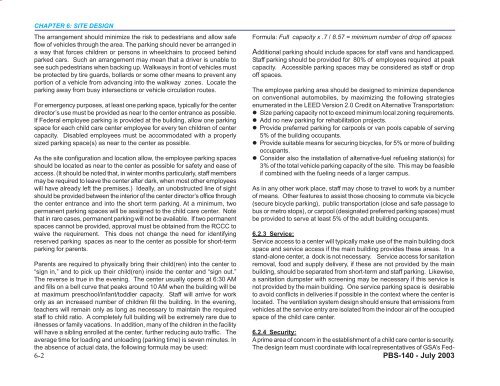PBS 140 Child Care Center Design Guide - The Whole Building ...
PBS 140 Child Care Center Design Guide - The Whole Building ...
PBS 140 Child Care Center Design Guide - The Whole Building ...
You also want an ePaper? Increase the reach of your titles
YUMPU automatically turns print PDFs into web optimized ePapers that Google loves.
CHAPTER 6: SITE DESIGN<br />
<strong>The</strong> arrangement should minimize the risk to pedestrians and allow safe<br />
flow of vehicles through the area. <strong>The</strong> parking should never be arranged in<br />
a way that forces children or persons in wheelchairs to proceed behind<br />
parked cars. Such an arrangement may mean that a driver is unable to<br />
see such pedestrians when backing up. Walkways in front of vehicles must<br />
be protected by tire guards, bollards or some other means to prevent any<br />
portion of a vehicle from advancing into the walkway zones. Locate the<br />
parking away from busy intersections or vehicle circulation routes.<br />
For emergency purposes, at least one parking space, typically for the center<br />
director’s use must be provided as near to the center entrance as possible.<br />
If Federal employee parking is provided at the building, allow one parking<br />
space for each child care center employee for every ten children of center<br />
capacity. Disabled employees must be accommodated with a properly<br />
sized parking space(s) as near to the center as possible.<br />
As the site configuration and location allow, the employee parking spaces<br />
should be located as near to the center as possible for safety and ease of<br />
access. (It should be noted that, in winter months particularly, staff members<br />
may be required to leave the center after dark, when most other employees<br />
will have already left the premises.) Ideally, an unobstructed line of sight<br />
should be provided between the interior of the center director’s office through<br />
the center entrance and into the short term parking. At a minimum, two<br />
permanent parking spaces will be assigned to the child care center. Note<br />
that in rare cases, permanent parking will not be available. If two permanent<br />
spaces cannot be provided, approval must be obtained from the RCCC to<br />
waive the requirement. This does not change the need for identifying<br />
reserved parking spaces as near to the center as possible for short-term<br />
parking for parents.<br />
Parents are required to physically bring their child(ren) into the center to<br />
“sign in,” and to pick up their child(ren) inside the center and “sign out.”<br />
<strong>The</strong> reverse is true in the evening. <strong>The</strong> center usually opens at 6:30 AM<br />
and fills on a bell curve that peaks around 10 AM when the building will be<br />
at maximum preschool/infant/toddler capacity. Staff will arrive for work<br />
only as an increased number of children fill the building. In the evening,<br />
teachers will remain only as long as necessary to maintain the required<br />
staff to child ratio. A completely full building will be extremely rare due to<br />
illnesses or family vacations. In addition, many of the children in the facility<br />
will have a sibling enrolled at the center, further reducing auto traffic. <strong>The</strong><br />
average time for loading and unloading (parking time) is seven minutes. In<br />
the absence of actual data, the following formula may be used:<br />
6-2<br />
Formula: Full capacity x .7 / 8.57 = minimum number of drop off spaces<br />
Additional parking should include spaces for staff vans and handicapped.<br />
Staff parking should be provided for 80% of employees required at peak<br />
capacity. Accessible parking spaces may be considered as staff or drop<br />
off spaces.<br />
<strong>The</strong> employee parking area should be designed to minimize dependence<br />
on conventional automobiles, by maximizing the following strategies<br />
enumerated in the LEED Version 2.0 Credit on Alternative Transportation:<br />
� Size parking capacity not to exceed minimum local zoning requirements.<br />
� Add no new parking for rehabilitation projects.<br />
� Provide preferred parking for carpools or van pools capable of serving<br />
5% of the building occupants.<br />
� Provide suitable means for securing bicycles, for 5% or more of building<br />
occupants.<br />
� Consider also the installation of alternative-fuel refueling station(s) for<br />
3% of the total vehicle parking capacity of the site. This may be feasible<br />
if combined with the fueling needs of a larger campus.<br />
As in any other work place, staff may chose to travel to work by a number<br />
of means. Other features to assist those choosing to commute via bicycle<br />
(secure bicycle parking), public transportation (close and safe passage to<br />
bus or metro stops), or carpool (designated preferred parking spaces) must<br />
be provided to serve at least 5% of the adult building occupants.<br />
6.2.3 Service:<br />
Service access to a center will typically make use of the main building dock<br />
space and service access if the main building provides these areas. In a<br />
stand-alone center, a dock is not necessary. Service access for sanitation<br />
removal, food and supply delivery, if these are not provided by the main<br />
building, should be separated from short-term and staff parking. Likewise,<br />
a sanitation dumpster with screening may be necessary if this service is<br />
not provided by the main building. One service parking space is desirable<br />
to avoid conflicts in deliveries if possible in the context where the center is<br />
located. <strong>The</strong> ventilation system design should ensure that emissions from<br />
vehicles at the service entry are isolated from the indoor air of the occupied<br />
space of the child care center.<br />
6.2.4 Security:<br />
A prime area of concern in the establishment of a child care center is security.<br />
<strong>The</strong> design team must coordinate with local representatives of GSA’s Fed-<br />
<strong>PBS</strong>-<strong>140</strong> - July 2003

















